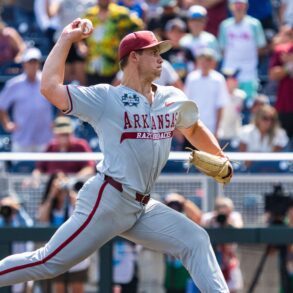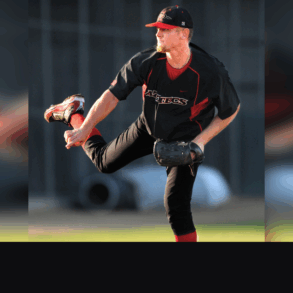
With fall practices complete and the college season a little over a month away, it is becoming clearer which freshmen are in line to have impact roles for their respective programs.
There are still position battles to be won once practice ramps up again after the holidays and freshmen across the country will play their way into prominent roles as the season progresses, but below you will find Baseball America’s initial top 25 freshmen ranking.
While the list does take prospect status into account, the biggest factor is how much impact said player is projected to have in their first year on campus.
1. Rintaro Sasaki, 1B, Stanford
Sasaki sent shockwaves through the college baseball world last fall when he announced that he would be forgoing the Nippon Professional Baseball Draft to attend college in the United States. He would eventually commit to Stanford and by April he was on campus, where he practiced with the team and continued to work with the coaching staff. Sasaki made his stateside debut this summer for the Trenton Thunder in the Draft League, hitting .221/.387/.395 with three doubles, four home runs and 17 RBIs across 26 games. He finished the summer with an outstanding nine-game stint in the Appy League in which he slashed .391/.913/1.508 with three home runs and eight RBIs.
At 6-feet tall and 289 pounds, Sasaki is as strong and as physical as they come. While his carrying tool is his 70-grade power, Sasaki also has a feel for the barrel and consistently generates quality contact. He boasts thunderous bat speed, as well as sound pitch recognition skills. Though he’s limited to first base defensively, Sasaki’s offensive prowess makes up for it. Sasaki projects to hit in the middle of Stanford’s lineup this spring and has ACC Freshman of the Year upside.
2. Brodie Johnston, 3B, Vanderbilt
Johnston didn’t have the same type of draft buzz as the other names mentioned on this list, but he is the only one who played on the college circuit this past summer. In the Appy League, Johnston hit .284/.351/.479 with six doubles, six triples, five home runs and 47 RBIs across 43 games. He was not only named an all-star, but took home MVP honors in the all-star game. Johnston carried over his hot hitting into the fall, launching three home runs across three fall World Series games. He’s a physical player who looks to do damage each time in the box, and he has an intriguing hit-power blend. Johnston has a quiet setup in the box with a wide base, and there is an appealing compact explosiveness to his operation. He also runs well and figures to make an impact on the base paths. Where Johnston fits defensively is a bit of a question mark, but his bat projects to be enough to have him be a consistent member of the starting nine in 2025.
3. Arnold “Jay” Abernathy, SS/OF, Tennessee
Abernathy last July had plenty of early-to-mid day two draft interest, so getting him to campus was a huge win for head coach Tony Vitello and his staff. Though it’s still early, Abernathy has a chance to set the table atop the Volunteers lineup come Opening Day. The quick-twitch Abernathy is not only a 70-grade runner, but also possesses plus bat-to-ball skills. He has plenty of quickness in his hands, and his swing is geared towards peppering the entire field with line drives. Abernathy puts pressure on opposing defenses, and his skillset enables him to affect the game in a number of ways. His speed and athleticism also translate in the field, where he is capable of handling an up-the-middle infield position and either center or left field. Abernathy this fall collected a pair of hits in both of Tennessee’s scrimmages and has seen time both on the dirt and in the outfield. With the Volunteers’ infield—from left to right—consisting of Andrew Fischer, Dean Curley and Gavin Kilen, Abernathy’s best path to consistent playing time will likely come in left field. However, he should seamlessly slide up to the dirt in 2026 since the aforementioned trio will all be drafted.
4. Sean Jenkins, RHP, East Carolina
Of all the arms on this ranking, Jenkins has the best chance to be his team’s Friday night starter. And in the spirit of full transparency, he may be the leader in the clubhouse right now for ECU. A strong and physical righthander, Jenkins re-classed from 2025 to 2024 and will be 17 for part of the season. He has a true four-pitch mix that includes a fastball that was up to 97 mph with riding life—it averaged over 18 inches of IVB this fall—two distinct breaking balls in a low-80s curveball and a mid-80s slider and a mid-80s splitter with which he does an excellent job killing spin. Jenkins generates whiffs with all fours and looks the part of a potential first-rounder come 2027.
5. Duncan Marsten, RHP, Wake Forest
Marsten looks like he could be one of the next great arms out of Wake Forest before all is said and done. After missing all of 2022 recovering from Tommy John surgery, Marsten last spring flashed huge stuff that led to him garnering top-four round draft interest. He has an effortless delivery and his fastball has been up to 99 mph, but it will sit in the low-to-mid 90s. In addition to his heater, Marsten boasts a pair of above-average secondary pitches in a low-80s slider and a mid-80s changeup. His changeup might be the better of the two, and this fall it has looked like a valuable weapon. Marsten has shown well early on, and in a recent scrimmage against West Virginia he struck out a pair and allowed just one hit across three shutout innings. The Demon Deacons need to replace their entire 2024 rotation, and while transfers Matthew Dallas and Logan Lunceford will account for two of the weekend rotation slots, Marsten could very well earn the final spot.
6. Dax Whitney, RHP, Oregon State
Whitney was one of the most popular helium arms in the 2024 draft cycle and had pitched his way into a potential day-one pick. He’s enjoyed a productive fall and is in a great spot to log meaningful innings this spring. At 6-foot-5 and 195 pounds, Whitney is an exciting, moldable ball of clay who has a prototypical pitcher’s frame with projection remaining. His fastball this fall has been up to 98 mph with life through the zone, and he supplements it with a curveball, slider and changeup. Whitney’s curveball is the best of his three secondary offerings, and it flashes big-time depth with sharp, downward teeth. His slider is shorter in shape, and his changeup is a fine fourth pitch. Whitney has the look of a future rotation headliner, and it might be sooner rather than later. He is in line to log plenty of innings this spring for Oregon State—the only question is in what role do they come.
7. James Nunnallee, OF, Virginia
Nunnallee this July was drafted in the 14th round by the Brewers, but he never swayed from his commitment to Virginia. He lit the world on fire this fall and was one of the Cavaliers’ best hitters. Nunnallee has an ultra-hitterish look in the box, with an advanced feel for the barrel, quick hands and polished approach. He uses the entire field and has shown impressive adjustability in his operation. It’s more extra-base hit than home run power right now, though it’s easy to envision Nunnallee adding impact as he continues to mature physically. He is capable of handling all three outfield positions, but this season will likely spend all of his time in either right or left field due to the return of potential top-five round pick Harrison Didawick.
8. Hunter Carns, C, Florida State
It’s hard to think of a freshman hitter who has had a louder fall than Carns. The 6-foot backstop had top-three round draft interest, but instead opted to honor his commitment to Florida State. This fall, Carns has been one of the Seminoles’ best hitters and is on track to be in the opening day lineup. He’s a high-level athlete who has serious bat and hand speed at the plate, and he’s routinely flashed his all-fields power. Carns is an advanced athlete, which is a trait that is consistently on display behind the dish, where he moves well laterally and boasts a strong arm. While he might be more of a supplementary option at the catcher position to junior Jaxson West, Carns’ toolset profiles well in the outfield, where his athleticism, speed and arm all translate. While Carns’ college career is still in its infancy stage, he has no-doubt day-one upside as a draft eligible sophomore in 2026.
9. Derek Curiel, OF, LSU
LSU netted the No. 1 2024 recruiting class and Curiel is a key reason why. The 6-foot-2 outfielder was always one of the more “famous” prep names in the 2024 class and garnered plenty of draft buzz. However, he saw his stock fall a bit last spring and eventually withdrew his name from the draft. It was a major recruiting win for head Coach Jay Johnson and company, and Curiel has hit the ground running this fall. It’s important to take fall numbers with a massive grain of salt, but it’s always better to perform than not. Curiel this fall finished second on the team with a .388 average, led the way with a .522 on-base percentage and his five doubles were tied for the second-most on the roster. He has a fluid, aesthetically-pleasing lefthanded swing that he pairs with a high-level approach and a present feel for the barrel. Curiel has an advanced baseball sense that is on display in the outfield, where he has strong instincts and takes efficient routes to the baseball. The biggest question mark is how much power he’ll eventually grow into, but regardless, he figures to hit in the top-half of the LSU order this spring.
10. Mason Russell, LHP, Arizona
Russell was one of the best pitching prospects in the Four Corners region of the country this past draft cycle and had top-five round interest, though when all was said and done, he ended up on campus. The 6-foot-1, 185-pound lefthander has a smooth, clean delivery, strength throughout his frame—especially in his lower-half—and an advanced feel to spin the baseball. Russell moves well on the mound and features a low-90s fastball that this fall has been up to 94 mph, a pair of potentially above-average breaking balls in a low-80s slider and a mid-to-upper 70s curveball and a mid-80s changeup. Russell’s curveball is arguably the better of the two, and it routinely flashes big-time depth with sharp, downward tilt. The biggest key for Russell during his time at Arizona will be adding polish in the pitchability department. He had an excellent fall to the tune of a minuscule 0.82 ERA with 12 strikeouts to three walks across 11 innings. Russell looks the part of a future weekend starter and eventual top-five round draft choice.
11. Myles Bailey, 1B, Florida State
Bailey was a top 200 draft prospect on the final BA 500, but he instead opted to honor his commitment to Florida State. The hulking 6-foot-4, 257-pound first baseman was one of the most productive hitters this fall for the Seminoles and is poised to hit in the middle-of-the-order come Opening Day. Bailey has plus-plus raw power, a tool that was on full display during the fall. He has effortless hand speed, and his bat path is one that is tailored towards getting the ball up in the air with authority. Bailey’s biggest bugaboo as a prepster was swing-and-miss, though this fall he showed improvement in that area and consistently put the ball in play. I will be curious to see if that carries over to the spring or if it was just a flash in the pan. Bailey has no issue getting to his immense power in-game, and he has 20-plus home run upside in 2025.
12. Owen Paino, SS, Mississippi
Paino had long been one of the more recognizable names in the 2024 class and had plenty of draft chatter in the lead up to the draft. He withdrew his name on July 14—day one of the draft—and while it was not as big a surprise as someone like William Schmidt, it was still a major win for Ole Miss. Paino has hit the ground running this fall, showing well in both intrasquad scrimmages and games against other programs. The 6-foot-3 infielder has solid control of the strike zone and a sound approach, and this fall he has gotten to his above-average power on a consistent basis. Paino has blasted a handful of home runs, and has also been one of the Rebels’ top performers in their scrimmages against North Alabama and Samford. The biggest key for Paino in order to achieve his offensive upside will be how his hit tool progresses, but the start to his college career has been encouraging. While last year’s starting shortstop Luke Hill is back, he could slide off the position to make room for Paino. Long term, his defensive skillset might translate best at the hot corner.
13. Tyler Bell, SS, Kentucky
Bell was drafted by the Rays in the second round of this year’s draft, but surprised many when he decided not to sign. Unsurprisingly, Bell has shown well this fall and is on track to be the Wildcats’ Opening Day shortstop. Bell is a fluid defender with silky smooth actions, an above-average arm and strong internal clock. He looks like a strong bet to stick at the position long term, and will provide a considerable boost to Kentucky’s defense this season. At the plate, Bell is a switch-hitter whose swing can get a little long at times, but he makes consistent contact and has flashed solid power from both sides, especially to the pull side as a lefthanded hitter. Bell has the tools on both sides of the baseball to be one of the more productive freshmen in the SEC this spring. Bell will be eligible for the draft again in 2026, where he again has day one upside.
14. William Schmidt, RHP, LSU
Schmidt had legitimate first-round interest in last July’s draft, but he sent shockwaves through the baseball world when he announced on night one of the draft that he would be attending LSU. The No. 22 ranked prospect on the final BA 500, Schmidt has an impressive arsenal that includes a mid-90s fastball that has been up to 98 mph, a low-to-mid-80s changeup that right now is a work-in-progress and—the headliner—a devastating low-80s curveball. Many had the pitch tabbed as the best of its kind in last year’s draft, and it is a high-spin offering with spin rates routinely in the 2,900+ range, big-time depth and a sharp 12-to-6 shape. It gets whiffs both in and out of the zone, and Schmidt has shown he can also land the pitch for strikes. LSU’s rotation is deep, but Schmidt is poised to log his fair share of innings this spring. The only reason why Schmidt is not ranked higher is because this ranking largely has to do with the projected impact each player will have in year one. So while Schmidt has top-half of the first round upside in 2027, he likely won’t pitch in its weekend rotation until 2026.
15. Talan Bell, LHP, Clemson
While he spent some of the fall dealing with an injury, Bell still opened plenty of eyes and is destined for a sizable role on the bump this spring. A two-way player in high school, Bell is highly advanced on the mound. His fastball would sit in the high-80s-to-low 90s as a prep, but it has been into the mid 90s this fall with running life through the zone. Bell also has an above-average mid-80s changeup in his arsenal, as well two distinct breaking balls in a low-80s slider and a mid-70s curveball that take on a bigger shape. As a cherry on top of his deep pitch mix, Bell is an advanced strike-thrower whose ability to locate helps his arsenal play up. Clemson isn’t afraid to give a freshman a major role if he’s earned it—see Aidan Knaak—and Bell could be next in line.
16. Charlie Bates, SS, Stanford
Bates had plenty of top-three round draft interest last year, but ended up choosing to honor his commitment to the Cardinal. He got his feet wet this summer with the Bellingham Bells of the West Coast League, and across three games, the 6-foot-1 shortstop went 5-for-11 (.455) with a home run and three RBIs. Bates has impressive hand-eye coordination and an advanced feel for the barrel, which translates to above-average contact skills. He grew into some more impact last spring, and while his power may be more extra-base oriented than over the fence, it could end up being solid-average when all is said and done. Bates’ smooth actions and soft hands give him a chance to stick at shortstop long term.
17. Sawyer Strosnider, OF, TCU
Strosnider is armed with an impressive toolset and is in a strong position to be in TCU’s starting lineup come Opening Day. He has big-time bat speed and plus power, especially to the pull side. Strosnider is a high-level athlete who is also a plus runner with a plus arm, both of which translate well to the outfield. He has an outstanding frame at 6-foot-2, 200 pounds, and while he roved center field in high school, he will likely man a corner spot for the Horned Frogs. In order for Strosnider to achieve his immense ceiling, he will need to clean up his hit tool and shore up his swing decisions.
18. Carson Wiggins, RHP, Arkansas
The 6-foot-5 Wiggins—younger brother of former Arkansas righthander and current Chicago Cubs prospect, Jaxon Wiggins—features a thunderous fastball that has been up to 99 mph. It’s a pitch he pairs with a sharp, above-average slider and a promising split-change. His strike-throwing ability will need to improve, but Wiggins is a mighty intriguing ball of clay that the Arkansas staff will be able to mold. Wiggins has already impressed this fall and was up to 101 with his heater in a scoreless appearance. He has a low-effort operation, though he will need to improve his consistency on an outing-to-outing basis. Wiggins this spring will log most, if not all of his innings in relief, but he could make the jump into the Hogs’ weekend rotation come 2026. A draft-eligible sophomore in 2026, Wiggins has top-two round upside.
19. Drew Rogers, C, Georgia Tech
Rogers projects to make an immediate impact on both sides of the baseball in his first year on campus. At 6-feet, 220 pounds, Rogers is plenty physical and possesses impressive pullside power and arm strength. He has a pull-oriented approach and is a power-over-hit profile right now, so it will be worth monitoring how his hit tool progresses going forward. Behind the dish, Rogers’ actions will need a couple coats of polish, but he has big-time arm strength. While he might not be the Yellow Jackets’ starting catcher on Opening Day, his bat is enough to net him a regular role in the starting nine.
20. Michael Catalano, RHP, Oklahoma
Catalano was one of the Sooners’ more highly-touted recruits and has really impressed this fall in Norman. He has an athletic frame at 6-feet, 190 pounds, with strength in his lower half and a simple, repeatable delivery featuring a shorter arm stroke and high-three quarters slot. Catalano’s fastball has been consistently in the 93-95 range this fall with carry, and he also features a mid-to-upper-70s curveball and an upper-70s-to-low-80s slider. He was particularly sharp in Oklahoma’s scrimmage against McLennan Community College and looks the part of a potential top-five round pick in 2026.
21. Rustan Rigdon, INF, Vanderbilt
Rigdon is one of the more fun and versatile players on this list, as the switch-hitting infielder is also an ambidextrous thrower. Though he underwent Tommy John surgery on his right arm in the fall of 2023, Rigdon last spring manned center field and was able to throw with his left arm. He’s a plus runner—a trait that translates well to the outfield—and is a polished hitter with present bat-to-ball skills. Rigdon is better from the left side than the right, where he has a smooth swing with present hand speed. He is a disciplined hitter who consistently puts together quality at-bats. Rigdon’s diverse skillset projects to be enough to give him a quality role this season.
22. William Kirk, LHP, Virginia
Kirk had top-five round buzz last July, but he heads to Charlottesville poised to log plenty of innings in year one. A highly advanced strike-thrower, his ability to locate the pitch is impressive despite a fastball that sits in the high 80s to low 90s. Kirk completes his arsenal with a mid-70s breaking ball and a high-70s plus changeup that frequently generates swings and misses. He enjoyed a productive fall and is squarely in the mix to pitch on the weekends in year one. Nothing in Kirk’s arsenal right now will blow you away from a sheer stuff perspective, but that figures to come as he continues to add strength. What Kirk excels at, and not many young arms can say the same at this point in their career, is he really knows how to pitch.
23. Noah Franco, 1B/LHP, TCU
Before reclassifying to 2024, Noah Franco was one of the premier players in the 2025 class. He has experience on the mound, but all signs point to him being a hitter long term. At 6-foot-3, 205 pounds, Franco is plenty physical and has a violent swing with impressive hand speed and pullside power. He had a standout fall at the plate for the Horned Frogs and took home MVP honors in their annual Fall World Series. Franco has an impressive frame and should only grow into more impact as he continues to mature. Defensively, he is athletic enough to handle a corner outfield spot when needed, though he moves well around the first base bag. Franco has also been up to 94 mph with a high-spin slider on the mound, but he will need to harness his stuff.
24. Chris Levonas, RHP, Wake Forest
A second-round pick in last July’s draft, Levonas is an ultra-athletic righthander who boasts one of the louder arsenals—at least from a pure stuff standpoint—of any freshman in the country. He has a high-effort delivery with plenty of arm speed and is armed with a fastball that has been up to 97 mph to go along with a trio of quality secondary offerings. He boasts a power curveball that takes on 12-to-6 shape and features sharp, downward tilt, and he supplements it with a high-spin slider in the low-80s and a firm changeup that, at times, will flash plenty of fade to the arm side. Levonas’ control can escape him at times, and while he is likely to log most of his innings in relief this spring, he seems destined to end up in Wake Forest’s weekend rotation come 2026.
25. Drew Rerick, RHP, Texas
Rerick more than looks the part at 6-foot-5, 230 pounds, and the former Texas A&M commit was a nice late get for coach Jim Schlossnagle and his staff. Rerick has some effort in his delivery and attacks from a high three-quarters slot. His fastball sits in the 92-95 range, but it’s been up to 97 mph with riding life at the top of the zone. In addition to his heater, Rerick mixes in two breaking balls in a harder slider and a slower curveball that pops out of his hand at times. The former is better than the latter, and Rerick rounds out his arsenal with a mid-80s changeup. He had a strong fall for the Longhorns and is in line to log his fair share of innings this spring.
This post was originally published on this site be sure to check out more of their content.





